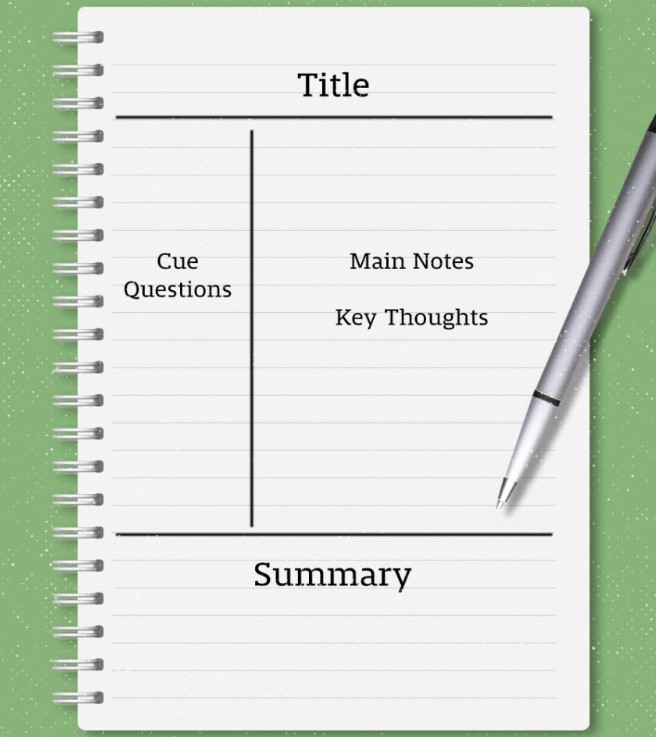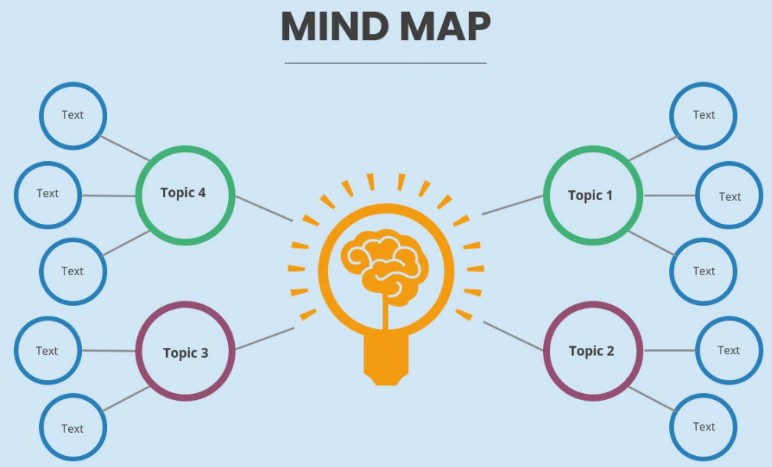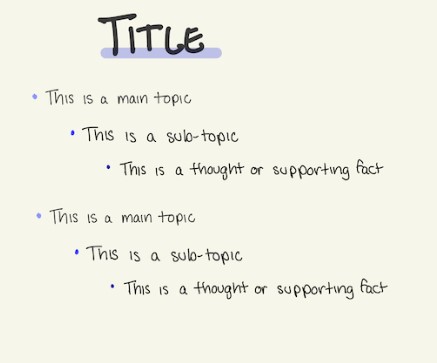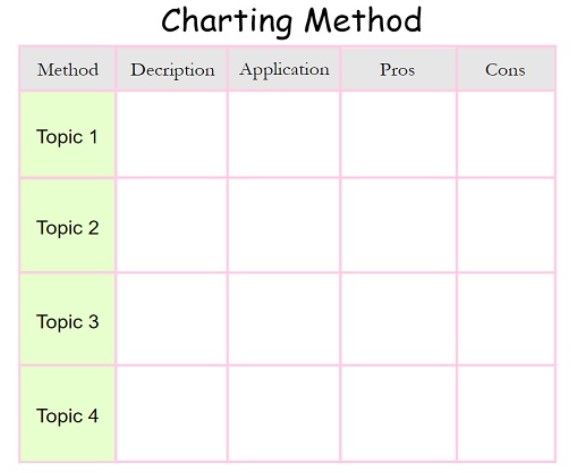Study hacks are strategies, techniques, or methods that help optimize the process of learning and studying. They are designed to improve efficiency, retention, and comprehension, allowing individuals to make the most of their study time and achieve better results. These hacks can be applied to various aspects of studying, such as organization, time management, memory retention, focus, and comprehension.
We have subdivided the complete article into steps. The steps are below mentioned –
1.Effective note-taking methods
Using efficient note-taking techniques will greatly improve your comprehension, memory, and review of study material. Here is a thorough explanation of a few well-liked note-taking techniques:
1.1 Cornell Method:

A system for taking, arranging, and reviewing notes is called the Cornell Method. This technique was developed in the 1950s by Cornell University professor Walter Pauk. Students must divide their paper into two columns with a row running across the bottom as part of this technique. The page layout of this approach is its main strength. Make a huge I on the page to begin creating your own Cornell Notes. You list the title of the class, meeting, or seminar along with the time and topic at the top of the page.
- Divide your note sheet into three sections: a narrow left column (about 2.5 inches), a wider right column (about 6 inches), and a bottom section (about 2 inches).
- Take lecture or reading notes in the right column, focusing on key concepts, main ideas, and supporting details. Use abbreviations, symbols, and bullet points to capture information concisely.
- After the lecture or reading, review your notes and write a summary or key points in the left column. These serve as cues during review.
- In the bottom section, write down questions or keywords related to the notes. This helps with active recall during review sessions.
1.2 Mind Mapping:

There is more to mind mapping than just a fancy approach to create a flowchart. This visual thought process helps you to pinpoint a key idea, generate a cloud of related ideas, and imaginatively analyze particular aspects of the original idea to ensure that you are taking into account all of its advantages or potential solutions.
This tool is wonderful for teams, but it also works well for business leaders who are casting vision, for students looking for the best approach to learn new material, and for individuals who want to streamline and organize their own personal goals.
- Start with a central concept or topic and draw a central node or bubble on your paper.
- Branch out from the central node with major subtopics, drawing lines to connect them.
- Further branch out from each subtopic with more specific details, using shorter lines or branches.
- Use colors, symbols, and images to visually represent relationships and aid memory.
- Mind maps are especially useful for visual learners and for organizing information hierarchically.
1.3 Outlining Method:

Many high-achieving pupils’ skill sets include the outline note-taking technique, which is essential. Students that perform well do not rely solely on their “intellectual gifts.” Instead, they put their efforts into mastering efficient study techniques that help them succeed every time.
One of the most basic yet efficient note-taking systems is this one. You will be well on your way to learning the technique and taking the most useful notes possible if you stick to the easy stages in this instruction.
- Use a hierarchical structure to organize your notes. Start with main headings (Roman numerals), followed by subheadings (capital letters), and then sub-subheadings (Arabic numerals).
- Each level of the outline should represent a progressively more specific detail or idea.
- Indentation or bullet points can be used to differentiate between different levels and to emphasize important points.
- This method is particularly effective for organizing information in a logical and structured manner.
1.4 Charting Method:

The charting method, commonly referred to as the “matrix method,” is a note-taking technique that uses diagrams to summarize and arrange notes. It entails dividing a document into a number of columns and rows, which are afterwards filled with informational summaries. As a result, a note format is created that makes it easy to compare various subjects and concepts.
To improve note-taking, the charting approach was developed. Because of this, it is obvious that it has offered numerous advantages over the years. You can print it off and distribute it, which saves you a ton of time.
- Create a table or chart to compare and contrast different aspects of the study material.
- Divide the table into columns and rows, labeling each column with a specific category or topic.
- Fill in the cells of the table with relevant information, making it easy to visualize relationships and differences.
- This method is particularly useful for subjects that involve comparisons, such as history, science experiments, or literature analysis.
1.5 sentence method:
Utilizing sentences to summarize and arrange your thoughts is part of the sentence method. You use your own words to compose statements that cover each topic and the related information. With a number in the margin, each new topic starts on a separate line.
- Use this method to write down notes in complete sentences, capturing important details and concepts.
- Focus on capturing the main ideas and supporting details, while maintaining coherence and clarity in your sentences.
- This method is suitable for subjects that require a comprehensive understanding of the material and for learners who prefer a more narrative style of note-taking.
It’s important to actively engage with the material, provide your own summaries, and develop a visual or organized structure for your notes that will help with comprehension and retention. Try out various approaches to determine which one suits you and the material you are learning the most. To reinforce learning and improve your comprehension of the subject, go through and edit your notes frequently.
2. Time management

For students to successfully balance their academic obligations, extracurricular activities, and personal lives, time management is essential. Here are some thorough explanations of time management strategies for students.
The key to effective time management for students is to give each day a purpose. It involves taking charge of your time and making it as productive, focused, and, most importantly, balanced as possible. Students must comprehend why time management is vital before we provide them a list of time management advice.
We all need to make the most of the brief time we have each day. It is quite simple to lose focus amid a flurry of competing tasks and produce less. Students who properly manage their time develop greater confidence, organization, and learning capacity. High school students need to be particularly adept at time management since they have a greater number of topics, tests, assignments, and extracurricular activities to manage. Students who use time management strategies can stay on task and handle the pressure of new obligations.
2.1 Prioritize tasks: Identify the most important and urgent tasks that need to be completed. Prioritization helps you allocate your time and energy effectively. Focus on high-priority tasks first to ensure they are completed on time.
2.2 Create a study schedule: Develop a study schedule or timetable that outlines dedicated study periods for each subject or task. Consider your energy levels and concentration patterns throughout the day. Allocate time slots for studying, assignments, projects, and revision, leaving buffer time for unexpected tasks or emergencies.
2.3 Break tasks into smaller chunks: Breaking down larger tasks or projects into smaller, manageable chunks helps avoid overwhelm and makes it easier to tackle them. Set specific, achievable goals for each study session, such as completing a certain number of pages, solving a set of problems, or summarizing a chapter.
2.4 Use time-blocking technique: Time-blocking involves allocating specific time blocks for different activities or tasks. Assign blocks of time for studying, attending classes, extracurricular activities, personal commitments, and relaxation. Stick to the allotted time for each task, and avoid multitasking to maintain focus and productivity.
2.5 Utilize the Pomodoro Technique: The Pomodoro Technique is a time management method that involves working in focused bursts followed by short breaks. Set a timer for 25 minutes of uninterrupted work (a “Pomodoro”), and then take a 5-minute break. After completing four Pomodoros, take a longer break of around 15-30 minutes. This technique helps maintain concentration and prevents burnout.
2.6 Avoid procrastination: Procrastination can be a major time-waster. Identify the reasons behind your procrastination and find strategies to overcome them. Break tasks into smaller steps, eliminate distractions, use self-imposed deadlines, and reward yourself upon task completion to combat procrastination.
2.7 Use technology tools: Leverage technology tools to enhance time management. Utilize calendar or task management apps to schedule and track deadlines, set reminders, and manage your commitments. Consider using productivity apps or browser extensions that block distracting websites or track your time spent on various activities.
2.8 Learn to say no: It’s important to set boundaries and learn to say no to non-essential commitments that may consume your valuable study time. Prioritize your academic responsibilities and focus on activities that align with your goals and values.
2.9 Regularly review and adjust: Regularly review your time management strategies to assess their effectiveness. Identify areas for improvement and make necessary adjustments to your schedule or techniques. Flexibility is key to adapting your time management approach based on changing priorities or unforeseen circumstances.
Keep in mind that discipline, self-awareness, and constant effort are necessary for efficient time management. Try out various methods to determine which ones are most effective for you. You may lessen stress, increase productivity, and create a better work-life balance as a student by managing your time well.
3. Active learning strategies

Approaches that actively include students in the learning process by fostering participation, analysis, and application of knowledge are known as active learning strategies. These techniques encourage in-depth comprehension, analytical thinking, and memory retention. Here is a thorough discussion of a few efficient active learning techniques.
3.1 Classroom discussions: Engage in active discussions with your peers and instructors. Share ideas, ask questions, and participate actively in group discussions. This helps you gain different perspectives, clarify concepts, and strengthen your understanding of the topic.
3.2 Questioning techniques: Actively ask questions during lectures or while studying. Formulate both higher-level thinking questions and clarifying questions to deepen your understanding and engage with the material. Reflect on the answers and seek further explanations when needed.
3.3 Peer teaching: Teach a concept or explain a topic to a fellow student. By teaching others, you reinforce your own understanding and identify areas where you may have knowledge gaps. This approach enhances your ability to articulate concepts and strengthens your grasp of the subject matter.
3.4 Case studies: Analyze real-life scenarios or case studies related to the subject. Apply theoretical knowledge to practical situations, identify problems, and propose solutions. This approach develops critical thinking skills and promotes the application of concepts in real-world contexts.
3.5 Problem-solving activities: Engage in problem-solving activities, such as solving practice questions, working on complex assignments, or participating in simulations. Actively apply your knowledge to solve problems, analyze different approaches, and evaluate outcomes. This fosters critical thinking, decision-making, and problem-solving skills.
3.6 Hands-on experiments or activities: For subjects like science, engineering, or arts, actively engage in hands-on experiments or creative activities. This experiential learning approach helps you understand concepts through practical application, observation, and experimentation.
3.7 Collaborative learning: Work in groups or pairs to complete assignments, projects, or study together. Collaborative learning encourages active participation, communication, and teamwork. It enables you to share ideas, discuss concepts, and learn from the perspectives and insights of others.
3.8 Visualization and graphic organizers: Utilize visual aids like mind maps, diagrams, flowcharts, or concept maps to organize and represent information visually. Creating visual representations of concepts enhances comprehension, facilitates connections between ideas, and aids in information recall.
3.9 Reflective writing or journaling: Engage in reflective writing or journaling to consolidate your learning. Write about your thoughts, insights, and personal connections to the material. Reflective writing encourages metacognition, self-assessment, and deeper understanding of the subject matter.
3.10 Role-playing or simulations: Participate in role-playing exercises or simulations that simulate real-life scenarios. This interactive approach allows you to actively engage with the content, make decisions, and observe the consequences of your actions. It promotes critical thinking, problem-solving, and empathy.
Keep in mind that active learning techniques call for your participation, curiosity, and desire to venture beyond of the realm of passive reading and listening. Active participation in the learning process improves understanding, memory, and the development of useful abilities that go beyond the classroom.
4. Memory techniques

Memory techniques, often called mnemonic devices or memory aids, are methods for enhancing memory recall and retention. These methods improve information encoding and retrieval through associations, visualization, and structure. Here is a thorough description of some efficient memory strategies.
4.1 Acronyms and Acrostics:
-
- Acronyms involve creating a word or phrase using the first letter of each item you want to remember. For example, “HOMES” is used to remember the names of the Great Lakes (Huron, Ontario, Michigan, Erie, Superior).
- Acrostics involve creating a memorable sentence or phrase where each word represents the first letter of the items you want to remember. For example, “Every Good Boy Does Fine” is a mnemonic to remember the notes of the lines on a treble clef (E, G, B, D, F).
4.2 Visualization:
-
- Visualize information in a vivid and memorable way. Create mental images that connect the information you want to remember with familiar or absurd scenes, objects, or people. The more unusual or exaggerated the visualization, the more memorable it becomes.
- Use spatial memory techniques, such as the method of loci or memory palace, where you mentally associate items with specific locations in a familiar place, such as your home. As you mentally navigate through the place, you can recall the associated information.
4.3 Chunking:
-
- Chunking involves breaking down large amounts of information into smaller, meaningful groups or “chunks”. This helps in organizing and remembering the information more easily.
- For example, instead of trying to remember a long string of numbers (785321954), you can chunk them into smaller groups (785-321-954) or create meaningful patterns (7853-2195-4).
4.4 Rhymes and Songs:
-
- Formulate rhymes, songs, or jingles to remember information. The rhythm and melody of rhymes and songs can aid in memory retention.
- For example, the “ABC” song is an effective way for children to remember the sequence of the alphabet.
4.5 Keyword Technique:
-
- This technique involves associating unfamiliar information with familiar words or phrases. First, identify a keyword related to the information you want to remember. Then, create a mental image or connection between the keyword and the new information.
- For example, to remember the French word for cat, “chat,” you can imagine a chat (pronounced “shat”) wearing a beret and meowing in a French accent.
4.6 Repetition and Spaced Repetition:
-
- Repetition involves repeatedly reviewing or reciting the information to reinforce memory. Regularly reviewing the material over time helps consolidate the memory.
- Spaced repetition involves reviewing the information at increasing intervals. This technique takes advantage of the spacing effect, which suggests that information is better retained when it is reviewed at spaced intervals rather than in one continuous session.
4.7 Mind Maps and Concept Mapping:
-
- Mind maps and concept maps visually represent relationships between concepts or ideas. By creating visual diagrams with interconnected nodes or branches, you can organize and reinforce the connections between different pieces of information. This aids in memory and comprehension.
4.8 Active Recall and Practice:
-
- Actively engage in recalling information from memory without relying on notes or resources. Testing yourself through flashcards, quizzes, or practice questions helps strengthen memory and identify areas that require further review.
4.9 Storytelling and Narrative:
-
- Create stories or narratives that incorporate the information you want to remember. By linking the information together in a narrative, you provide context and meaning, making it easier to recall.
5. Utilizing technology tools

The effectiveness, efficiency, and structure of student learning can all be significantly improved by the use of digital tools. Here is a comprehensive explanation of how students can use technology resources.
5.1 Note-Taking and Organization:
-
- Digital note-taking apps like Evernote, Microsoft OneNote, or Google Keep allow students to take, organize, and access their notes across various devices. These apps often include features such as tagging, searchability, and synchronization, making it easy to find and review notes.
- Task management and organization tools like Trello or Todoist help students create to-do lists, set reminders, and prioritize tasks. They can break down assignments into smaller subtasks and track their progress.
5.2 Collaboration and Communication:
-
- Online collaboration platforms such as Google Drive, Microsoft Teams, or Dropbox provide a centralized space for students to collaborate on group projects, share documents, and provide feedback in real time.
- Communication tools like Slack or Microsoft Teams facilitate effective communication among students, allowing them to ask questions, share resources, and coordinate their work efficiently.
5.3 Digital Libraries and Research:
-
- Online research databases and libraries such as JSTOR, Google Scholar, or academic databases provided by universities offer access to a vast range of scholarly articles, research papers, and books.
- Reference management tools like Zotero, Mendeley, or EndNote assist students in organizing their research materials, generating citations, and creating bibliographies.\
5.4 Online Learning Platforms:
-
- Learning management systems like Moodle, Canvas, or Blackboard are commonly used by educational institutions to deliver online courses, share course materials, facilitate discussions, and assess student progress.
- Online learning platforms like Coursera, Udemy, or Khan Academy offer a wide range of courses, tutorials, and resources on various subjects, allowing students to supplement their learning or explore new areas of interest.
5.5 Productivity and Time Management:
-
- Productivity apps like Forest, RescueTime, or Focus@Will help students manage their time, minimize distractions, and track their progress. They may provide features like time tracking, website blockers, or the Pomodoro Technique for better time management.
- Calendar apps such as Google Calendar or Microsoft Outlook enable students to schedule classes, assignments, exams, and extracurricular activities, providing reminders and ensuring they stay organized.
5.6 Virtual Laboratories and Simulations:
-
- Virtual laboratory tools or simulations are available for subjects like science, engineering, or medicine. These tools allow students to conduct experiments, practice techniques, and explore concepts in a virtual environment, supplementing or replacing traditional lab experiences.
5.7 Language Learning and Skill Development:
-
- Language learning apps like Duolingo, Rosetta Stone, or Babbel provide interactive lessons, vocabulary exercises, and pronunciation practice in various languages.
- Online platforms like LinkedIn Learning, Udacity, or Skillshare offer courses and tutorials on a wide range of skills, including programming, design, marketing, and more.
5.8 Digital Study Resources:
-
- Online flashcard platforms like Quizlet or Anki allow students to create and review flashcards, often with features like spaced repetition to optimize learning and memory retention.
- Educational YouTube channels, podcasts, and online forums provide additional learning resources, explanations, and discussions on various subjects.
It’s crucial that students select technology tools that suit their requirements, preferences, and academic objectives. While technology can be very helpful, it’s important to maintain a balance and make sure that it encourages active participation, critical thinking, and deep connections with the material.
6. Optimal study environment for students

To enhance focus, concentration, and productivity, students must create the ideal study environment. A thorough explanation of how to create the optimum study environment is provided below:
6.1 Choose a quiet location: Find a quiet area where you can study without distractions. It could be a library, a dedicated study room, a coffee shop, or a quiet corner in your home. Minimize noise by closing windows, using noise-canceling headphones, or playing instrumental music if it helps you concentrate.
6.2 Remove distractions: Minimize potential distractions that can disrupt your focus. Turn off notifications on your phone or put it in another room. Consider using website blockers or productivity apps to limit access to distracting websites or social media platforms during study sessions.
6.3 Ensure proper lighting: Study in a well-lit environment to avoid eye strain and fatigue. Natural light is ideal, but if that’s not possible, use a bright desk lamp or overhead lighting to ensure adequate illumination. Avoid studying in dimly lit areas, as it can lead to drowsiness and reduced concentration.
6.4 Comfortable study area: Create a comfortable study area that supports good posture and reduces physical discomfort. Invest in an ergonomic chair and desk, if possible. Keep your study materials, stationery, and equipment within reach to minimize unnecessary movements and interruptions.
6.5 Organize study materials: Keep your study materials well-organized and easily accessible. Use folders, binders, or digital tools to categorize and store your notes, textbooks, handouts, and other study resources. This saves time and helps maintain focus during study sessions.
6.6 Use a clutter-free workspace: Clear your study area of unnecessary clutter and distractions. A clean and organized workspace can have a positive impact on your mindset and focus. Keep only essential materials and remove any items that can divert your attention.
6.7 Personalize the space: Customize your study environment to suit your preferences and make it more conducive to learning. Some students find it helpful to add motivational quotes, artwork, or plants to create a pleasant and inspiring atmosphere.
6.8 Adequate ventilation: Ensure proper ventilation in your study area to maintain fresh air flow. Poor air quality can lead to drowsiness and reduced cognitive function. Open windows for fresh air when possible, or use a fan or air purifier to maintain a comfortable and oxygen-rich environment.
6.9 Temperature control: Maintain a comfortable temperature in your study environment. Extreme heat or cold can be distracting and uncomfortable. Adjust the temperature or use fans, heaters, or blankets to create an optimal working environment.
6.10 Break areas: Designate specific areas for taking short breaks. Having a separate space to relax, stretch, or grab a snack can help recharge your energy and prevent burnout. Avoid studying in your break area to maintain a clear distinction between study and relaxation zones.
Keep in mind that every person has unique tastes and study techniques. Try out several components and modify the setting to your liking. Make regular adjustments to your study space to keep it encouraging and favorable to effective learning.
The goal of study hacks is to optimize learning results by utilizing tried-and-true procedures and approaches. As everyone may have a different learning style and inclination, these hacks are not necessarily the best answers. It’s crucial to experiment with these hacks and modify them to fit unique requirements and tastes. People can improve their ability to learn, save time, and perform better academically by adding study hacks into their routine.
Also Read the other Article on Time Blocking which is useful for the students too.